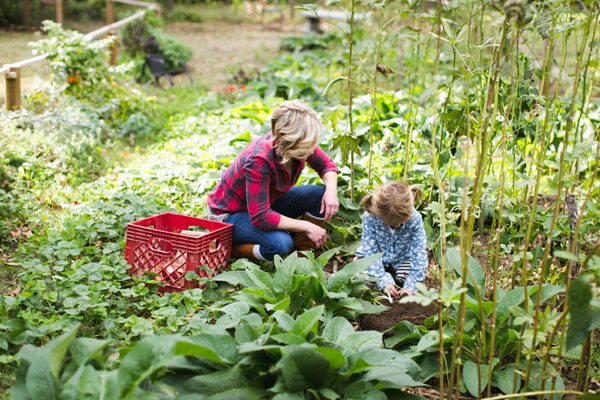Photo courtesy of Jessie Leigh Photography. Tulsa, OK.
Flowers and shrubs in Oklahoma are known to earn their keep. With the high winds, clay soil and unpredictable weather, it’s hard to believe they can thrive in such elements. Each year, the Oklahoma Proven Selections program tests multiple species of trees, shrubs and flowers for their ability to survive in Oklahoma’s landscape.
These 15 plants are the most weather, pest and disease resistant around. Additionally, they’re multi-season and require low levels of maintenance. So before you make a trip to Lowe’s or the local greenhouse, keep this list handy for easy growing all season long.
1. Korean Spice Viburnum
A Korean Spice Viburnum is a fairly easy shrub to grow — and lasts for three seasons. It prefers moist, well-drained soil in full sun. During the spring, clusters of buds will open into gorgeous white and pink flowers. If you’re sensitive to smell, be aware. This species packs a spicy fragrant punch. Later during the summer months, its berries will transform with the wine-red hues of fall.
2. Valley Forge American Elm
Of all the Elms on the market, the Valley Forge species has shown to be the most disease resistant. It’s characterized by its broad V-shape form, yellow autumn color and eventually reaches 60 feet tall. American elms are known to adapt in various soil condition — not to mention, they’re resistant to ice salts, air pollution and drought. We don’t know about you, but that’s one tough cookie (or tree in this case).
3. Red Chokeberry
Chokeberry prefers average soil in full sun or part shade and reaches 6-10 feet tall. This shrub features clusters of white and light pink flowers during spring — providing tons of nectar for hummingbirds and butterflies. During the autumn months, glossy red fruit replaces the blossoms and extends on into the winter.
4. Giant Coneflower
In love with the colors of summer? We may have found your match. Native to Oklahoma, the Giant Coneflower prefers moist, well-drained soil in full sun. It reaches 5-6 feet tall and features beautiful golden-petaled flowers surrounding a dark cone. This species is known for attracting butterflies. And in the late summer, finches and birds. One of the most notable benefits of Giant Coneflower is that the blue stems and foliage don’t require staking in later seasons.
5. Persian Ironwood
Known as the best in small trees, this Persian species grows 20-40 feet fall in full sun or part shade. It blooms in early spring — before the foldable unfurls, bearing red and white flowers. The foliage itself is a mix of red and purple that transforms into a glossy green during summer. During the cooler months, it transforms yet again but into a combination of yellows and oranges.
6. Diabolo Ninebark
Looking for real showstopper in your landscaping efforts. The Diabolo Ninebark shrub grows 4-8 feet tall and thrives in a range of soil conditions. This particular species features deep purple foliage accompanied by white and pink flowers — bearing small purple fruit. In areas with warmer climates, you’ll notice that the foliage actually becomes greener. A true chameleon, is it not?
7. Bosnian Pine
Native to southeastern Europe, the slow-growing Bosnian Pine is an evergreen with an upright, pyramid form. It prefers full sun, average garden soil and is pretty drought-resistance. This tree species grows 20-30 feet tall, which makes it a great choice for suburban gardens. The branching is someone open which pairs well with yews and spruces in landscaping.
8. Shantung Maple
If you’re interested in an underdog, Shantung Maple is an often overlooked small tree — perfect for Oklahoma gardens. Growing 25-30 feet tall, it’s quite versatile and can tolerate both wet or dry climates. Its foliage has a red tint which changes to green in summer and sunset hues in the fall.
9. Magnus Purple Coneflower
Magnus is a 2.5-3 foot tall staple in many gardens. It requires full sun, well-drained soil and is a hotspot for butterflies. The center cones are orange and turn brown when matured — which are great for attracting small birds. One of the many perks of this plant is the flowers. They’re often used in dried arrangements, allowing use beyond their prime seasons of growth.
10. Winter Jasmine
It’s rare you come across plants that bloom in winter, but it appears we have a contender. Winter Jasmine does well in drained, sandy soil with regular moisture, and can reach 12-15 feet tall. We recommend planting it on the south side of your home where it’ll receive the best winter light. Additionally, it’s known to be a climber. You can pair it with a trellis or allow it to fall naturally over a wall.
11. Japanese Painted Fern
The Japanese Painted Fern prefers full to part shade in moist, rich soil. This species can grow up to 12-18 inches tall and is very low maintenance. With its metallic silver-gray foliage with hints of red and blue, it’s a wonderful stand-out piece with Hosta, Foam Flower and Sedge.
12. Silver Linden
Silver Linden prefers moist, well-drained soil in full sun. Reaching up to 50-70 feet tall and 25-35 feet wide, it’s tolerant of pollution in urban areas. Also known as a lime tree, it’s beautifully shaped and characterized by its dark green and silvery foliage. During summer, it blooms soft yellow flowers and attracts butterflies.
13. Bald Cypress
Bald Cypress is a unique species. It prefers acidic soil, full sun and reaches a height of 50-70 feet tall. At first glance, it looks like an evergreen tree with its needles. But, around autumn, the needles will turn copper-orange and fall to the ground.
14. Arizona Cypress
Wish it could be Christmas year ‘round? The Arizona Cypress is a native tree which is sometimes used during the holidays. Strangely fast-growing, it reaches up 20-30 feet tall and 15 feet wide. This species is also great for windbreaks, erosion control and can stand up to harsh winds (which we all know too well in Oklahoma). Worried about the warmer months? No problem, the Arizona Cypress is drought-tolerant once established and provides beautiful gray-green texture to your garden.
15. Lenten Rose
Lenten Rose is a perennial that grows 1-2 feet tall and does best in well-drained rich soil in partial or full shade. It prefers being sheltered from cold wind and is fairly deer-resistant in wooded areas. Lenten rose got its name because it flowers bloom in late winter, the time of Lenton season. The flowers themselves range in color from white to purple. It’s most often planted in groups due to its green foliage — which provides fantastic ground cover.
Do you grow any of these plants in your Oklahoma garden or landscape?
If you’re still in the midst of planning your yards for the spring season ahead, let us lend you a hand. Just give us a call at (405) 824-8353 and we’d be happy to discuss your project over a free estimate.



